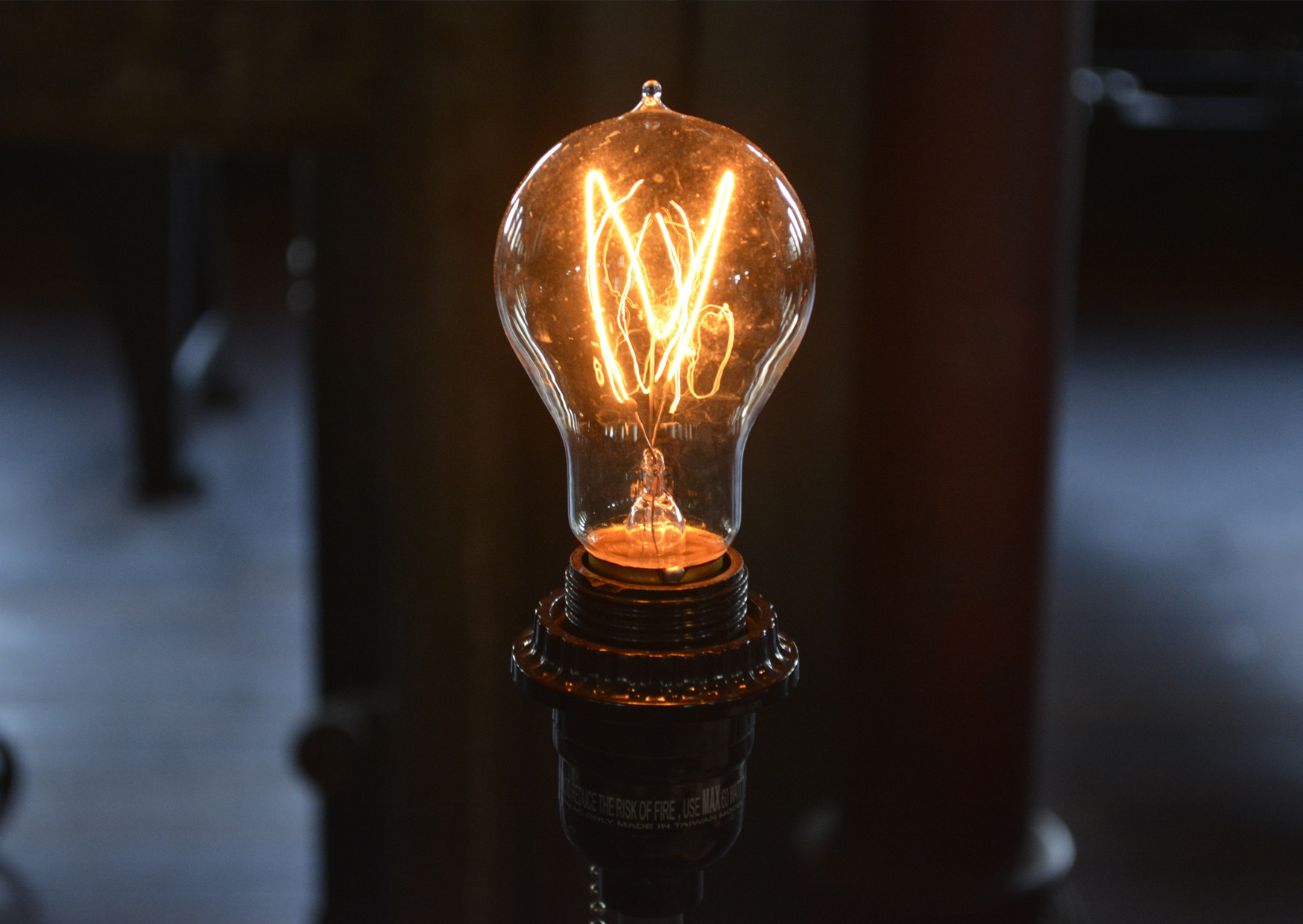History of a Light Bulb
Rebecca Matulka
podle https://www.energy.gov/articles/history-light-bulb
[...]
Incandescent Bulbs Light the Way
Long before Thomas Edison patented – first in 1879 and then a year later in 1880 – and began commercializing his incandescent light bulb, British inventors were demonstrating that electric light was possible with the arc lamp. In 1835, the first constant electric light was demonstrated, and for the next 40 years, scientists around the world worked on the incandescent lamp, tinkering with the filament (the part of the bulb that produces light when heated by an electrical current) and the bulb’s atmosphere (whether air is vacuumed out of the bulb or it is filled with an inert gas to prevent the filament from oxidizing and burning out). These early bulbs had extremely short lifespans, were too expensive to produce or used too much energy.

Zdroj
When Edison and his researchers at Menlo Park came onto the lighting scene, they focused on improving the filament – first testing carbon, then platinum, before finally returning to a carbon filament. By October 1879, Edison’s team had produced a light bulb with a carbonized filament of uncoated cotton thread that could last for 14.5 hours. They continued to experiment with the filament until settling on one made from bamboo that gave Edison’s lamps a lifetime of up to 1,200 hours – this filament became the standard for the Edison bulb for the next 10 years. Edison also made other improvements to the light bulb, including creating a better vacuum pump to fully remove the air from the bulb and developing the Edison screw (what is now the standard socket fittings for light bulbs). [...]
What makes Edison’s contribution to electric lighting so extraordinary is that he didn’t stop with improving the bulb – he developed a whole suite of inventions that made the use of light bulbs practical. Edison modeled his lighting technology on the existing gas lighting system. In 1882 with the Holborn Viaduct in London, he demonstrated that electricity could be distributed from a centrally located generator through a series of wires and tubes. Simultaneously, he focused on improving the generation of electricity, developing the first commercial power utility called the Pearl Street Station in lower Manhattan. And to track how much electricity each customer was using, Edison developed the first electric meter
While Edison was working on the whole lighting system, other inventors were continuing to make small advances, improving the filament manufacturing process and the efficiency of the bulb. The next big change in the incandescent bulb came with the invention of the tungsten filament by European inventors in 1904. These new tungsten filament bulbs lasted longer and had a brighter light compared to the carbon filament bulbs. In 1913, Irving Langmuir figured out that placing an inert gas like nitrogen inside the bulb doubled its efficiency. [...] But by the 1950s, researchers still had only figured out how to convert about 10 percent of the energy the incandescent bulb used into light and began to focus their energy on other lighting solutions.
Fluorescent lamps
In the 19th century, two Germans – glassblower Heinrich Geissler and physician Julius Plücker – discovered that they could produce light by removing almost all of the air from a long glass tube and passing an electrical current through it. [...] Discharge lamps became the basis of many lighting technologies, including neon lights, low-pressure sodium lamps (the type used in outdoor lighting such as street lamps) and fluorescent lights. [...] In 1976, Edward Hammer at General Electric figured out how to bend the fluorescent tube into a spiral shape, creating the first compact fluorescent light (CFL). [...] Since the 1990s, improvements in CFL performance, price, efficiency (they use about 75 percent less energy than incandescents) and lifetime (they last about 10 times longer) have made them a viable option for both renters and homeowners.
LEDs: The Future is Here
One of the fastest developing lighting technologies today is the light-emitting diode (or LED). A type of solid-state lighting, LEDs use a semiconductor to convert electricity into light, are often small in area (less than 1 square millimeter) and emit light in a specific direction, reducing the need for reflectors and diffusers that can trap light. They are also the most efficient lights on the market. Also called luminous efficacy, a light bulb’s efficiency is a measure of emitted light (lumens) divided by power it draws (watts). A bulb that is 100 percent efficient at converting energy into light would have an efficacy of 683 lm/W. To put this in context, a 60- to 100-watt incandescent bulb has an efficacy of 15 lm/W, an equivalent CFL has an efficacy of 73 lm/W, and current LED-based replacement bulbs on the market range from 70–120 lm/W with an average efficacy of 85 lm/W.
Otázky
- Kdo vynalezl dnes používanou žárovku?
- Popište, jak vypadala Edisonova žárovka. Jaké byly její přednosti, a jaké byly nevýhody?
- Pod kterými dalšími vynálezy je Edison podepsán?
- Čím se liší současné žárovky se žhaveným vláknem od původní žárovky Edisonovy?
- Porovnejte světelnou účinnost žárovky, zářivky a LED svítidla.
- Najděte český ekvivalent pro „arc lamp“, „filament“, „lifespan“, „socket“, „tungsten“, „discharge lamp“, „fluorescent lamp“.

